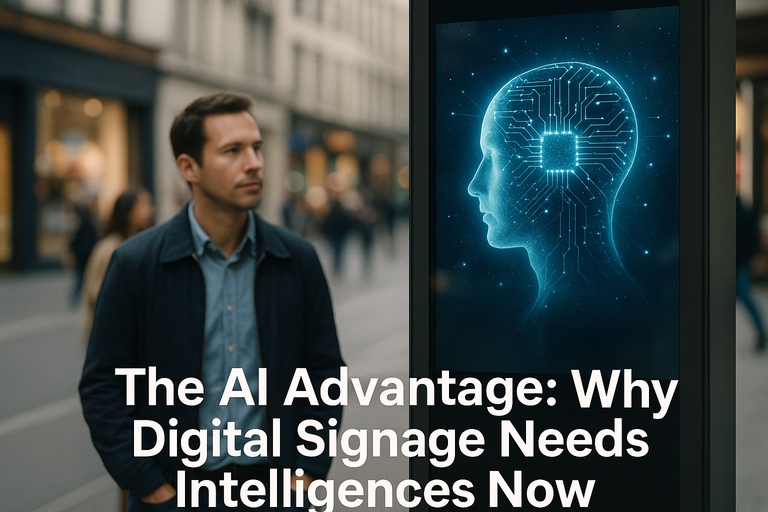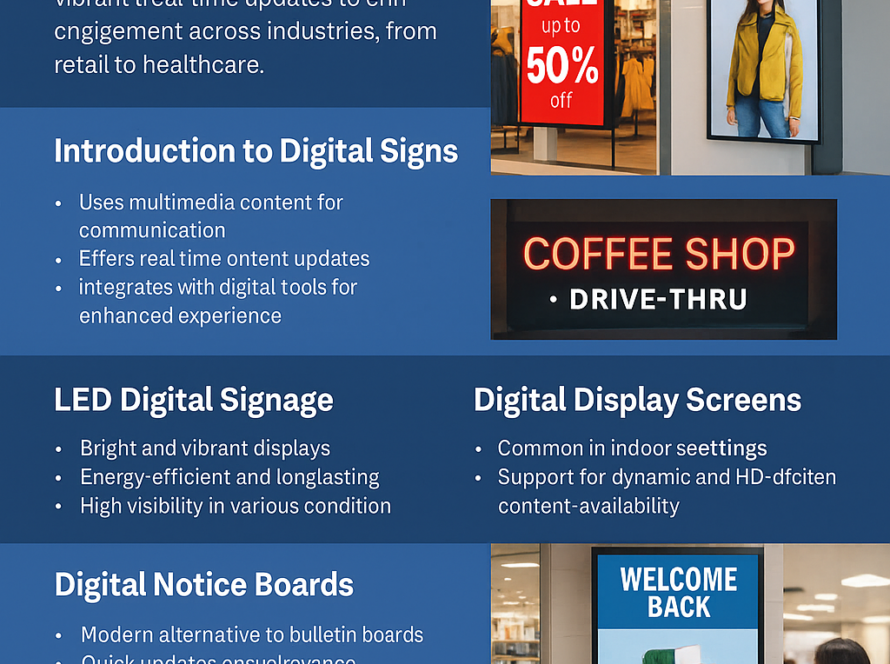The fusion of artificial intelligence (AI) with digital signage is transforming what screens can do for businesses and public spaces. Where once digital signage simply looped content, today, AI is powering a data-driven revolution across retail, hospitality, restaurants, corporate environments, and especially outdoors. These smart, adaptive displays not only deliver targeted messages but learn, predict, and respond dynamically, creating a new gold standard for engagement and operational efficiency.
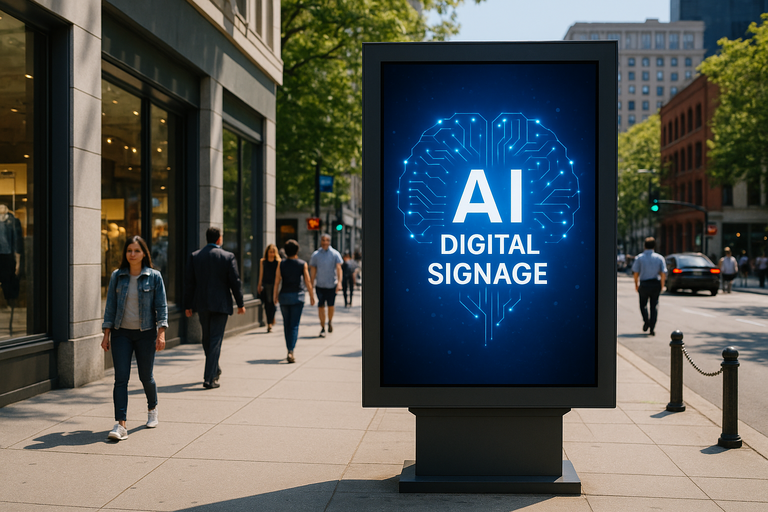
The Intelligent Foundation: How AI is Redefining Digital Signage Displays
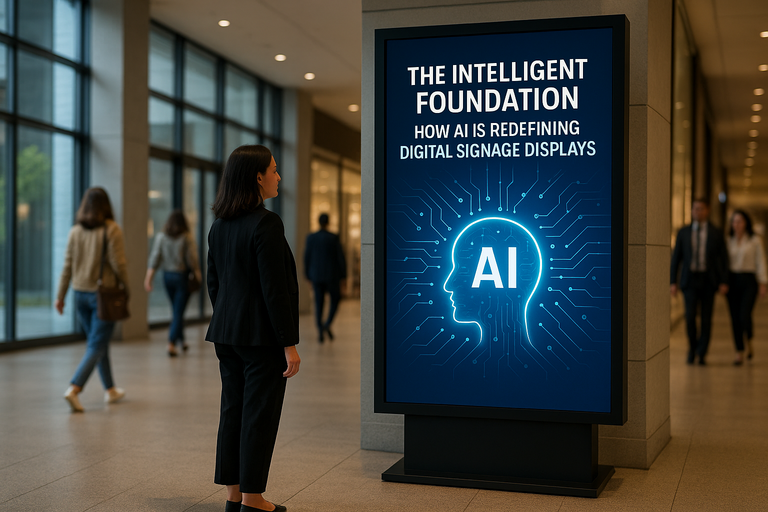
Digital signage displays have come a long way from static posters and single-loop videos. AI integration has unlocked features like facial analytics, context-aware content rotation, and automated content creation, giving businesses a new level of control and targeting. This paradigm shift is not just about better screens – it’s about transforming displays into intelligent endpoints that are integral to business strategy and customer experience.
Modern digital signage displays leverage edge and cloud-based AI to analyze audience demographics, foot traffic, peak browsing times, and more—all without storing identifiable personal data. This empowers displays to show the right message, to the right audience, at precisely the right moment. For example, an in-store retail screen might prioritize promotions for sneakers during a teenage rush, then switch to luxury watches for business professionals later the same day.
This adaptive capability has a host of benefits. Scheduled content can react in real-time to external data like the weather, local events, or POS inventory. AI tools can even measure dwell times, engagement, and optimize content layouts for both readability and impact. AI attention metrics and heatmapping have become central to understanding what really captures attention, informing everything from creative design to merchandising tactics.
Beyond marketing, smart digital signage displays now drive real business outcomes—shortening perceived wait times, streamlining internal communications, reducing energy use through intelligent brightness control, and feeding actionable data back to marketing and operations teams. With robust content management systems and plug-and-play hardware/software integration, even small businesses can deploy powerful AI-driven networks.
In short, AI has bridged the gap between mere digital display and fully realized, interactive, and outcome-oriented digital signage. This transformation is visible in industries from retail to education, where displays are now indispensable communication and engagement tools.
Restaurants in the AI Era: Digital Signage for Seamless, Data-Driven Dining
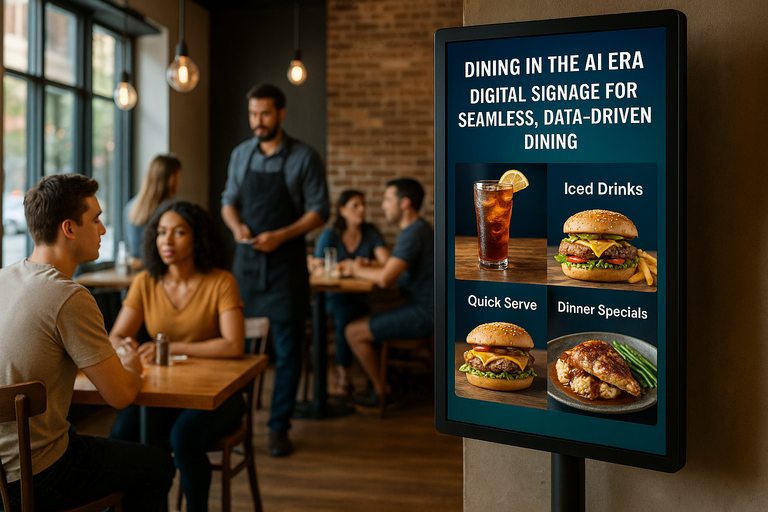
The restaurant industry has embraced digital signage with enthusiasm—but the real leap forward comes from the integration of AI. No longer are menus static or promotional boards generic. AI transforms digital signage for restaurants in dynamic, measurable ways, driving sales through intelligent upselling, automated menu switching, and hyper-relevant promotions.
Imagine walking into a restaurant where the digital menu adapts in real time to inventory and demand: selling more iced drinks on a hot day, highlighting quick-serve options when lines are long, or showcasing dinner specials as evening approaches. By integrating with the POS system, AI can pull best-sellers, adjust displays to highlight low-stock items, and automate price updates without staff intervention.
Restaurants now routinely use AI-powered image generators to keep visuals fresh and on-brand. Platforms offer workflow tools that let owners auto-generate mouthwatering food shots or seasonal themes with just a simple prompt. According to practical guides, writing detailed prompts ensures digital content stays relevant and consistently appealing to diners.
The impact stretches beyond the menu. AI-powered digital signage entertains and informs guests during the ordering process, reduces perceived wait times, and reinforces brand identity with seamless thematic transitions throughout the day. Interactivity—like touch to customize a meal, or scan to order and pay—elevates the entire dining journey.
For chains and multisite operations, centralized screen control and automated scheduling ensure brand consistency and rapid deployment of national campaigns, while localization still shines through at the store level. Such efficiency saves time, reduces waste, and maximizes revenue opportunities. As demonstrated by companies like Sign Inspire, restaurant signage is no longer decoration—it’s a revenue engine, made smarter and more agile through AI.
Outdoor Digital Signage: Elevating Public Engagement with AI
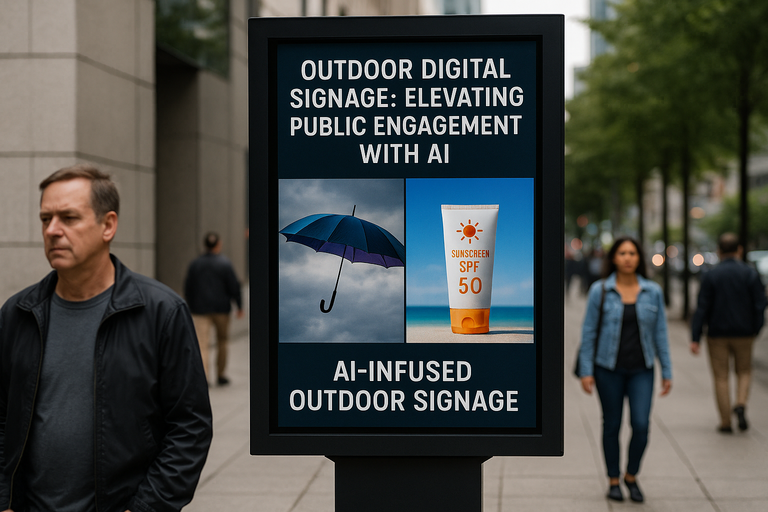
Outdoor digital signage must be robust, resilient—and now, intelligent. Modern outdoor digital signage units withstand harsh elements, boasting high-brightness, glare-resistant LED panels that adapt automatically to full sun or inclement weather. But the biggest leap forward comes from AI, which transforms every display into a living, responsive communication platform.
AI-infused outdoor signage in Australia, for example, seamlessly integrates with weather APIs to switch content instantly as conditions change—promoting umbrellas when rain looms or advertising sunscreen during midday sun. Event-driven triggers enable real-time advertising near stadiums, festivals, or during local special occasions, ensuring displays are always relevant and compelling to passersby.
Crucially, AI audience analytics empower outdoor signs to adapt content based on observed demographics, foot traffic density, and even “dwell time.” Using advanced, GDPR-compliant optical sensors, the signage remains anonymous but astute, ensuring the right content reaches the appropriate audience. Advertisers benefit from never-before-seen targeting precision in public spaces—luxury products during business hours, family-friendly offers for evening crowds, and dynamic support for public safety messaging during emergencies.
Managing networks of hundreds or thousands of outdoor screens is made manageable by AI-powered content management. Automated scheduling, predictive maintenance alerts, and energy-optimization routines drastically cut operational costs and maximize ROI. Even smaller players can now run “smart” billboard campaigns that previously demanded extensive manual oversight and expensive labor.
For cities and enterprises, intelligent outdoor digital signage is an essential part of the smart city revolution—managing pedestrian flows, broadcasting service updates, and even supporting live event navigation with context-aware wayfinding. The result: screens that not only display information but actively shape public experience.
Industry Use Cases: AI-Driven Digital Signage in Action

The use cases for AI-powered digital signage are exploding, with sectors adopting the technology to solve real business and communication challenges. Here’s how AI is delivering tangible results across four high-impact scenarios:
1. Retail: Shopping centers and boutique stores use AI-enabled displays to promote products based on shopper demographics, current weather conditions, and sales data. Interactive kiosks provide wayfinding, and real-time inventory-driven promotions adjust instantly as stock levels change. Retailers have seen significant sales uplifts and better brand recall, while AI-driven analytics inform everything from window displays to shelf-edge screens.
2. Restaurants: From quick-service cafes to fine-dining chains, restaurants harness AI to change menus automatically based on demand, offer limited-time upsells, and keep digital content fresh with generative image workflows. Digital menu boards reduce perceived wait times, keeping guests engaged, while back-of-house signage alerts staff when ingredients are running low or service speed needs to improve, streamlining the entire operation.
3. Real Estate and Public Spaces: Real estate offices and public venues deploy AI digital signage for immersive property showcases, interactive building navigation (using wayfinding digital signage), and community announcements. Computer vision-enabled kiosks greet visitors in multiple languages and instantly adjust content for event days or emergency alerts. High-brightness screens adapt to window and lighting conditions, keeping displays clear and persuasive 24/7.
4. Outdoor Advertising & Smart Cities: City governments and transit authorities use AI-driven digital billboards and information kiosks to issue public service announcements or navigate city traffic based on real-time congestion data. Synchronized outdoor screens promote events, manage crowds, and monitor engagement to improve content effectiveness over time. Utility companies leverage these networks to issue weather warnings or critical safety updates only in relevant areas, further elevating the role of outdoor digital signage as a trusted community resource.
Emerging Trends: What’s Next for AI-Powered Digital Signage?
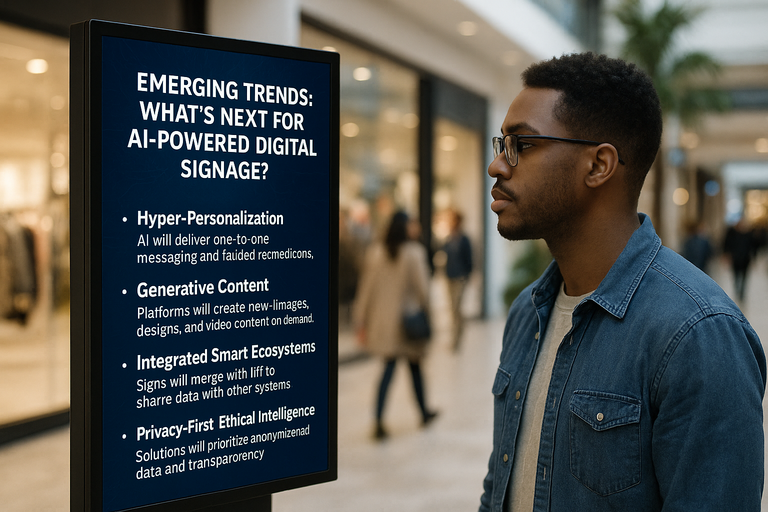
Looking forward, the intersection of AI and digital signage promises even greater leaps in personalization, automation, and integration with advanced technologies:
- Hyper-Personalization: AI will deliver not just segment-based content, but true one-to-one messaging. Expect networked screens to greet loyalty members by name (with consent) or offer tailored product recommendations based on purchase history and geolocation—already a reality in leading retail chains.
- Generative Content: Platforms now leverage AI to create new product images, seasonal designs, and even video content on demand. Restaurant owners can conjure up a new menu theme, retailers can refresh sale banners daily, and campaigns enjoy limitless creative variation—no graphic designer required.
- Integrated Smart Ecosystems: Outdoor and indoor signs are merging with IoT to share data with POS, CRM, HVAC systems, and more. For example, a shopping mall display might change content based on the number of shoppers in a zone, or a hospital’s digital signage could prioritize urgent updates when medical staff badges enter a room.
- Privacy-First, Ethical Intelligence: As AI permeates public spaces, privacy and transparency are critical. Leading solutions prioritize anonymized, aggregated data, and make it easy for consumers to understand (and control) what’s collected. Regulatory compliance, such as GDPR and new regional standards, drives the adoption of responsible AI—essential for both public trust and long-term brand success.
In addition, advances in computer vision, voice, and gesture recognition will soon let users interact with signage without touch—part of a broader, post-pandemic push for safer, more accessible digital experiences. Expect digital aids like real-time translation and accessibility support to become standard across restaurants, airports, and government buildings.
Conclusion: The Next Frontier for Digital Signage is Intelligent, Connected, and Human-Centric
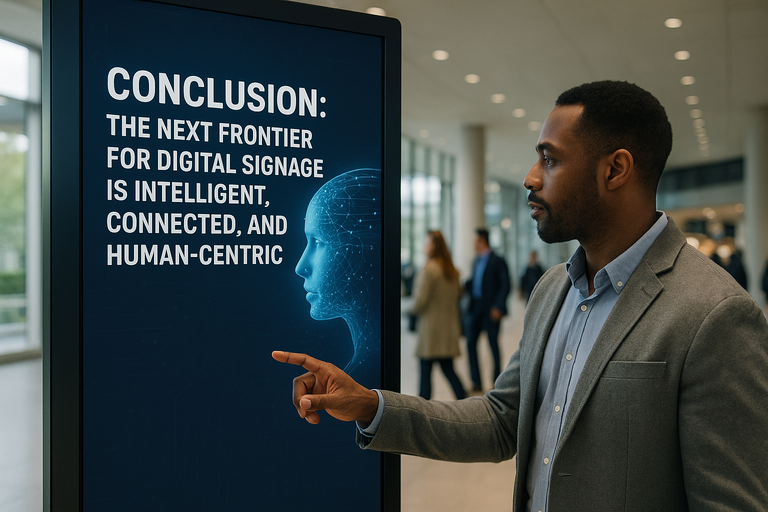
The journey of digital signage—from simple screens to truly intelligent, AI-powered communication platforms—promises more than just operational efficiency. It marks a bold new era where every display becomes a multi-dimensional channel for engagement, insight, and brand storytelling.
Restaurants deploy digital signage for restaurants to streamline operations and accelerate sales. Retailers drive footfall and brand loyalty by combining dynamic in-store displays with cross-channel strategy. Cities, airports, and venues use outdoor digital signage not only for advertising but as live, adaptive information hubs that keep communities safe and connected.
AI stands at the heart of these transformations—an enabler, optimizer, and creative force. With every leap in capability, the core principle remains: use technology to create more meaningful, more personal, and more powerful human experiences. As displays become smarter, more integrated, and highly adaptive, the future of communication belongs to those who see beyond the screen—to what’s possible when intelligence, context, and empathy converge.
Explore more on these trends:
– How Digital Signage is Transforming Restaurant Sales
– Wayfinding Digital Signage for Modern Spaces
– Transform Retail with Digital Signage Displays
– The Future of Outdoor Digital Signage in Australia
– Read More Digital Signage Stories


